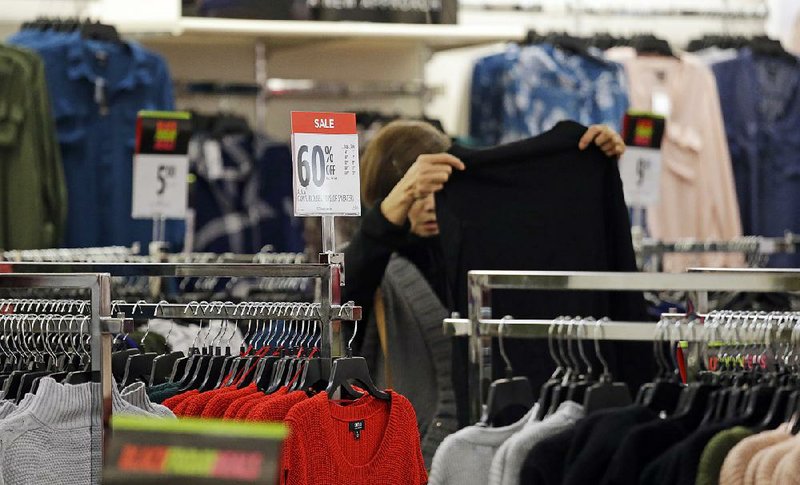WASHINGTON -- Consumer prices jumped more than expected last month, the Labor Department said Wednesday, adding to the fear of higher inflation that has roiled financial markets in recent days.
The consumer price index increased 0.5 percent in January, up from 0.2 percent the previous month and well above analyst estimates. The annual inflation rate was 2.1 percent, the same as it was for the 12 months that ended Dec. 31.
Higher prices for energy, particularly gasoline, as well as for apparel fueled the sharp increase in the index, which recorded its largest month-over-month jump since September.
Although the consumer price index is not the most important measure of inflation, its release Wednesday took on out-sized importance as investors scrambled for any new details about the direction of the economy.
Concerns that inflation is accelerating, which could lead to higher interest rates, caused last week's stock market declines. And the new data on consumer prices rekindled those concerns Wednesday even though the annual inflation rate held steady.
"January inflation did come in hot and higher than expected, there's no doubt about it ... but it's not too alarming," said Scott Anderson, chief economist at Bank of the West.
But he noted, the Commerce Department reported Wednesday, that retail sales fell unexpectedly in January, posting their biggest drop in nearly a year. Sales fell 0.3 percent after a flat December, as Americans cut back on purchases of automobiles and building supplies.
Anderson said the disappointing retail sales data indicate that inflationary pressures from higher consumer spending haven't developed, despite many workers receiving one-time bonuses linked to the tax cut legislation enacted late last year.
"The narrative doesn't hold together if inflation is being driven up by demand, the strengthening of the labor market and wage growth because it wasn't visible in the retail sales data," he said.
While the retail figures support analyst forecasts that consumption will slow this quarter, consumer spending will likely be buttressed this year by wage growth, a tight labor market and the tax cuts.
"These reports tell two stories: one, that the real economy may not be as strong as we thought, but also that inflation may be a bit higher," said Paul Ashworth, chief U.S. economist for Capital Economics. "The Fed looks like they're leaning towards the inflation part of the story."
The so-called core consumer price index, which excludes often-volatile food and energy costs, increased 0.3 percent in January. That was up from 0.2 percent the previous month.
The annual rate for the core consumer price index held steady last month at 1.8 percent.
The Federal Reserve has an annual inflation target of 2 percent, a level that indicates rising wages but not an overheating economy.
In December, Fed officials penciled in three interest-rate increases for 2018 in their most recent set of quarterly economic projections. That already incorporated expectations for a bump in inflation this year -- to 1.9 percent.
"Inflation pressures are perking up in the U.S. economy," said Leslie Preston, senior economist at TD Ameritrade. "Inflation has been the missing piece in the puzzle for rate hikes over the past several months."
Inflation has been stubbornly low throughout the recovery from the recession, which has helped keep interest rates at historically low levels and made stocks an attractive investment option.
Central bank policymakers monitor all inflation measures, including another that covers wholesale prices. But they judge their annual target on the federal government's broader personal consumption expenditure price index, which tends to show lower inflation than the consumer price index.
The consumer price index measures the change in prices paid by urban consumers for a variety of goods and services, including food, housing, clothing, health care and recreation.
The consumer price index covers only purchases made directly by consumers. The personal consumption expenditures price index is calculated differently and includes more services, such as health care paid for by employer-provided insurance, and Medicare and Medicaid.
The personal consumption expenditure price index showed a 1.7 percent increase in the 12 months ending Dec. 31, the most recent data available. That was down from 1.7 percent for the 12-month period that ended Nov. 30.
The core personal consumption expenditure price index, which excludes food and energy prices, was up 1.5 percent year-over-year through Dec. 31, holding steady from the previous reading.
Inflation fears were sparked on Feb. 2 by the latest jobs report.
It showed that average hourly earnings in January jumped 2.9 percent over the previous 12 months. That was the largest year-over-year percentage gain since 2009. But it's unclear if wage growth has really taken off, causing analysts and investors to look to other barometers to gauge inflation.
Information for this article was contributed by Jim Puzzanghera of the Los Angeles Times, Katia Dmitrieva of Bloomberg News and Christopher Rugaber of The Associated Press.
Business on 02/15/2018

